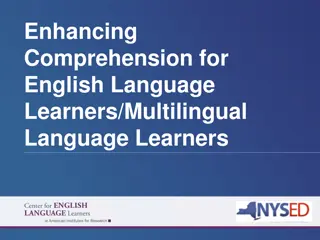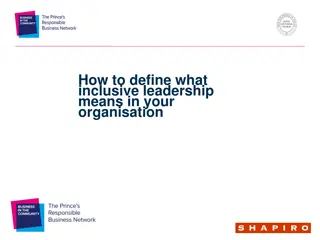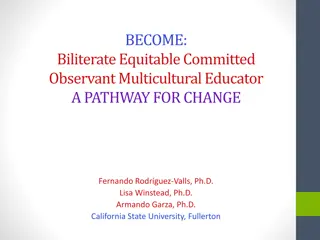Facilitating an Inclusive World for VI Learners
Core training resource focusing on how to create inclusive environments for children and young people with vision impairments. Covers barriers, intervention approaches, social experiences, and good practice principles. Promotes understanding and valuing individual perspectives.
Download Presentation

Please find below an Image/Link to download the presentation.
The content on the website is provided AS IS for your information and personal use only. It may not be sold, licensed, or shared on other websites without obtaining consent from the author.If you encounter any issues during the download, it is possible that the publisher has removed the file from their server.
You are allowed to download the files provided on this website for personal or commercial use, subject to the condition that they are used lawfully. All files are the property of their respective owners.
The content on the website is provided AS IS for your information and personal use only. It may not be sold, licensed, or shared on other websites without obtaining consent from the author.
E N D
Presentation Transcript
Curriculum Framework for Children and Young People with Vision Impairment (CFVI): Core Training Resource 2 Area 1: Facilitating an Inclusive World
Project Partners There are 4 partner organisations involved in the CFVI project. The production of these training/continuing professional development materials was led by VIEW (The Professional Association for the Vision Impairment Education Workforce), in association with a consultation group of stakeholders working in the field of VI Education.
Curriculum Framework for Children and Young People with Vision Impairment (2022, p.15)
Training objectives (1) To provide: An introduction to Area 1 of the CFVI Facilitating an Inclusive World. Examples of potential barriers to facilitating inclusion for learners with vision impairment and targeted intervention approaches we can draw upon to help reduce these. An opportunity to reflect on the social experiences and developmental paths of individual young people with vision impairment. Good practice principles for supporting learners with vision impairment in education. Some links to useful resources/websites.
Training Objectives (2) Customisable slide if needed (see notes for the previous slide which give examples of training objectives that you could consider, depending on the nature of your presentation).
About this area Area 1 of the CFVI has a focus on how we can all work together to facilitate a more inclusive world for children and young people with vision impairment. At the heart of this area is a social model of support, with a focus on inclusion and inclusive or universal practice, ensuring physical and social education environments are accessible for all children and young people with vision impairment. We can all help facilitate a more inclusive world through working towards understanding and valuing the individual perspective of the child/young person.
Why a focus on this area is important Children and young people with a VI will encounter a wide range of barriers to access and participation in education e.g. clutter in a corridor preventing safe access, not being able to see a visual demonstration on a whiteboard; resources not modified correctly for individual needs. Socially, childhood vision impairment can mean inability to use eye- contact to make connections, or difficulty in locating friends/knowing what others are laughing about in a group. Many barriers to access and participation can be reduced through targeted intervention approaches as outlined in the CFVI.
Examples of targeted intervention approaches for Area 1 listed in CFVI (1) Identification, recognition, and understanding of the specific and holistic needs and rights of a child and young person by all involved in their learning pathway. Environmental audits with input from specialist practitioners, to support accessible physical environments, including classroom space and general school environment. Creation of accessible social environments (peers). Knowledgeable and empowered family around the child and young person. Supporting transitions as the child/young person moves between settings.
Examples of targeted intervention approaches for Area 1 listed in CFVI (2) Availability of accessible and appropriate learning materials, as directed by specialist professionals. Availability of accessible and appropriate learning tools, such as appropriate assistive technology, tablet computers and computers. Creation of accessible social environments (community, work and lifelong education). Accessible infrastructures (e.g. networks, libraries, internet spaces, virtual learning environments, transport). Availability of accessible information for independence in adulthood (e.g. from private and public services).
Identifying and reducing barriers to access through targeted intervention approaches (1) Example of barrier to access Targeted intervention approach - what we can do to reduce barrier ? Clutter in a corridor preventing safe access for a learner ? Pupil reports feeling isolated during breaktime Pupil not being able to see a visual demonstration in a classroom ? ? Tactile sign on toilet door is inaccessible for pupil in wheelchair ?
Identifying and reducing barriers to access through targeted intervention approaches (2) Example of barrier to access Targeted intervention approach - what we can do to reduce barrier
Good practice principles for supporting CYPVI in education These five good practice principles provide an introduction to some key areas we should all be aware of when supporting students with vision impairment in education: 1. Collaborative working with other practitioners. 2. Getting to know the child as an individual learner. 3. Inclusive environment adjustments. 4. Inclusive classroom practice. 5. Facilitating independence.
Principle 1: Collaborative working with specialist practitioners Teachers - work with specialist practitioners with expertise in vision impairment for advice and support (i.e. QTVI, QRHS). Use these practitioners as a resource for guidance to help you develop your own expertise e.g. sighted guide, producing accessible resources, access technology, touch typing skills etc. You can find out from these practitioners about specialist equipment the education setting may require in order to facilitate inclusion. Plan with these practitioners how specialist teaching will fit alongside core teaching activities e.g. when the pupil is learning mobility.
Principle 2: Getting to know the learner as an individual Find out about the family background, history of what has and hasn't worked well in terms of support, interests beyond education, their eye condition and how it affects learning i.e. get to know the whole child. Careful observation of how the learner uses their vision in different environments is very helpful. Rather than focusing on what they are not able to do find out what helps with their learning in particular subjects or contexts. Conversations can include a discussion about the adjustments that they might need for exams or assessments, and about the access technology they are using. Be aware that the way in which the child/young person learns or the adjustments that are needed may change over time.
Principle 3: Inclusive environment adjustments Promoting clutter free spaces (corridors, cloakrooms etc). Use of tactile coat pegs and high contrast/tactile signage. Clearly labelled markers for top and bottom of stairs. Lighting - particularly in dark areas; blinds in classrooms to manage outside light etc. How the setting space is used- e.g. keep left systems on stairs, how to join lunch queue, etc. Lunch and break times can be particularly challenging think about potential barriers to participation and how these can be reduced.
Principle 4: Inclusive classroom practice (1) To ensure children/young people with vision impairment are suitably included in education consider the following: Drawing on guidance from the QTVI, ensure that the child/young person has access to learning material in a format that they are able to access, and ensure that this is available from the start of the lesson. Through reference to guidance from the QTVI, adapt learning tasks so that they are accessible e.g. adapted games or rules in PE, offering the option of 3D art activities. Exercise clarity in use of language when giving instructions (e.g. rather than saying the cupboard over here, you might say the cupboard next to my desk at the front of the classroom).
Principle 5: Facilitating Independence Don t feel a need to do everything for the child/young person and wherever possible help him or her to develop their independence - step back and help the child/young person develop their independence! Support/encourage the child/young person to use any assistive tools that she or he might have to enable independence, such as a cane, low vision aid, tablet computer, or laptop. Support the child/young person with the development of independent access skills wherever possible e.g. the use of assistive technology so the child/young person does not rely on others to provide access to materials. Promote opportunities for self-advocacy so the child/young person develops confidence in speaking about his or her visual condition and support needs. Be aware that using non-sighted methods for accessing tasks can take additional time and may require additional skills (e.g. understanding how to navigate a tactile diagram).
Principle 4: Inclusive classroom practice (2) Address each child/young person by their first name where possible so they know who you are addressing. Consider how inclusive the classroom learning environment is to a child/young person with vision impairment e.g. lighting, clutter, contrast, design of display boards, use of key vocabulary in a setting (often displayed on classroom walls). Be creative and incorporate teaching approaches that draw on other senses so there is not an overreliance on learning through visual means. Consider using organised peer support for particular activities (e.g a playtime buddy; group work in the classroom).
Facilitating an inclusive world for (name) 1. Collaborative working with other practitioners provide an overview of the collaborative working, who was involved, their respective roles etc. 2. Getting to know the child/young person as an individual learner provide an overview of their vision impairment, what this means for learning and participation, how information is disseminated etc. 3. Inclusive environment adjustments provide examples of the inclusive environmental adjustments that have been made (or are planned) to promote access to learning. 4. Inclusive classroom practice (access to learning) provide examples of classroom practice approaches that have been drawn up (or planned) to promote access to learning. 5. Facilitating independence (learning to access) - provide examples of approaches that are drawn upon (or planned) to promote learning to access skills.
Summing Up Do get to know the child/young person, their VI and what barriers they experience in order to support them most effectively. We can all help facilitate a more inclusive world through working towards understanding and valuing the perspective of the individual. We can all help advocate for inclusive schools and community environments which enable children and young people to flourish and develop their personal agency, and to help remove barriers to access participation. We all have an important role as facilitators for children and young people with vision impairment and prepare them for life in future settings (Areas 2-11).
What resources are available The Bookshare Hub hosting resources to support the delivery of the CFVI is available from RNIB (External) Of particular relevance to this area is Facilitating an Inclusive World The CFVI provides a list of targeted intervention approaches (page 18) Curriculum Framework for Children and Young People with Vision Impairment | RNIB
References Hewett, R., Douglas, G., McLinden, M., James, L., Brydon, G., Chattaway, T.,Cobb, R., Keil, S., Raisanen, S., Sutherland, C., Taylor, J., (2022) Curriculum Framework for Children and young People with Vision Impairment [CFVI]: Defining specialist skills development and best practice support to promote equity, inclusion and personal agency. RNIB Whole School SEND (NASEN): Supporting students with vision impairment: https://www.birmingham.ac.uk/research/victar/resources/whol e-school-send.aspx























